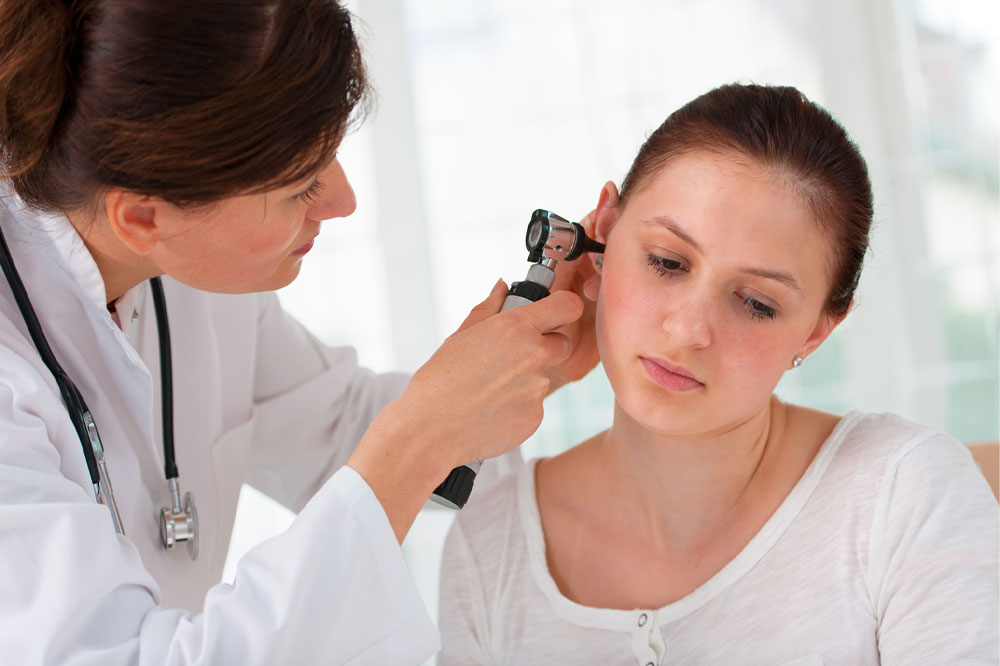Ear Infections – Symptoms, Diagnosis, and More
Ear infections come in several forms, and that of the middle ear is known as acute otitis media. The term “otitis media with effusion” refers to another ailment that affects the middle ear by fluid accumulating and causing a middle ear infection. The appropriate treatments for such earaches include natural home remedies such as warm compresses, over-the-counter options, olive oil in the affected ear, and certain essential oils.
Symptoms
Children normally suffer from issues like
Earache
Being fussy or irritable
Rubbing or pulling at the ear
Trouble falling asleep
Common symptoms experienced by adults are
Inflammation and pain
Hearing problems
Nausea and vomiting
Dizziness
Fever and headache
Swelling of the ear
Immediate attention is needed when there is fever, ear discharge, vertigo, loss of hearing, or diminished hearing coupled with ear pain.

Diagnosis
A doctor can identify a middle ear infection by discussing your child’s symptoms and performing an examination. They will inspect the eardrum and check for pus in the middle ear while examining inside your child’s ear.
The body’s immune system frequently treats middle ear infections on its own. Sometimes antibiotics are not needed for treating middle ear infections. However, immediate antibiotic treatment is required for severe middle ear infections or infections that continue longer than two to three days. Your doctor could advise watchful waiting or delaying the prescription of antibiotics for a minor middle ear infection.
Your doctor might prescribe a painkiller that also lowers fever and discomfort due to a virus or bacterial infection. Reye’s syndrome, an uncommon illness that can result in liver or brain enlargement, poses a threat. Using a heating pad with low heat can also help to lessen pain. When using a heating pad on a youngster, exercise extreme caution.
Treatment
Infections from bacteria and viruses are the most frequent causes of ear infections. Due to congestion and edema in the throat and nasal passages, the infection frequently spreads to the middle ear during a cold, flu, or allergies. Age, infection intensity, kind (first-time, continuous, or repeated infection), and whether or not the fluid is present in the middle ear for an extended time all affect how an infection is treated.
Antibiotics
Antibiotics can aid ear infection-causing bacteria, but they are ineffective against viral infections. Depending on the source of the infection and your symptoms, doctors can offer medical advice, diagnosis, and treatment for an ear infection, which may or may not involve antibiotics. Follow all the directions if your doctor prescribes antibiotics. Even if you or your child is feeling better, take all the prescribed dosages. If you miss a dosage or become ill while taking the prescriptions, contact your doctor at once. If you don’t finish the course, your infection could return and develop resistance to additional medications.
Drainage
Myringotomy surgery may be recommended if an infection results in major problems, the fluid stays in the ear for a prolonged time, or your child has recurrent ear infections. It helps alleviate pain, enhance hearing, and reduce the potential amount of infections your child may contract.
Natural Remedies
If your symptoms are minor, you can use home remedies like getting lots of rest and drinking more fluids to reduce the discomfort and swelling brought on by an ear infection. For example, gargling with salt water might help clear the eustachian tubes in the ears and ease a sore throat. The eustachian tube, which controls air pressure and drains fluid from the middle ear, is a canal that joins the middle ear to the back of the nasal cavity and the upper region of the throat. To reduce earaches in adults and children, take these steps at home after discussing them with your doctor:
Providing warmth by using a compress
A hot compress could make you feel more comfortable.
Eardrops
Earaches may be treated with over-the-counter ear drops. Ear drops can be created at home or bought commercially. If an ear has any discharge, ear drops shouldn’t be used in that ear unless a doctor specifically instructs you to.
Gargling
Salt water may help clear the Eustachian tubes and soothe a scratchy throat in older kids or adults.
Standing position
Your middle ear can be drained by keeping your head upright.
When to Contact the Doctor
When left alone or treated at home, earache frequently goes away in two to three days. Often, all that is required is to take a painkiller and check for worsening symptoms. Recognizing when your discomfort may be a sign of a more serious problem is critical. Consider making a doctor’s appointment if,
- You notice that your ear is leaking fluid, such as pus or blood.
- You’re dizzy, have a headache, or have a high fever.
- You think something is in your ear.
- You notice swelling behind your ear, particularly if the muscles on that side of your face are stiff or feel weak.
- Your excruciating ear pain abruptly disappears (which could mean a ruptured eardrum).
- Your symptoms don’t get better or worsen in 24 to 48 hours.
If left untreated, adult ear infections can have major side effects, such as hearing loss. Additionally, an untreated illness may spread to other bodily regions. A doctor’s advice can assist someone in managing their symptoms, treating the infection, and taking precautions to avoid getting the illness again.